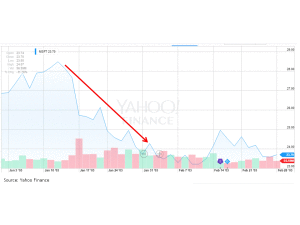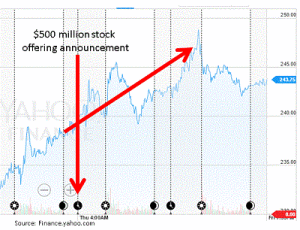Tesla just announced a $500 Million Common Stock Offering. In other words Tesla is issuing new shares in return for $500 million of cash. This money is to be used for expanding its business including Tesla Energy, the development of its next car – Model 3 and building a giga-factory. The announcement also said “Elon Musk, Tesla’s CEO, intends to purchase $20 million of common stock in this offering at the public offering price.”
What do you make of Tesla’s announcement to issue $500 million to fund capital projects?
As an investor, would this lead you buy Tesla’s stock or would you pause if you were planning to invest in Tesla stock? If corporate actions were signals, what could you infer from this move?
What is Signaling in the World of Corporate Finance?
The word signal is generally defined to convey information or instructions by means of a gesture, action, or sound.
Actions speak louder than words.
In the world of finance, investors are looking for signs of performance or opportunity or weakness. What corporate management says and believes may not always align. Since actions speak louder than words, looking at their action often will give a clear indication about their belief or conviction. For example, I may say that a stock is overvalued or undervalued or any number of things. My actions however, will generally reflect my true conviction. If I buy a stock, it is safe to assume (I am signaling) that I believe that this stock is under priced and it is likely to go up. The underlying assumption is that I am a rational investor and I would like to increase my profits/wealth so I would only buy when I expect the stock price to increase.
In corporate finance, we focus on the action of the management and try to read or interpret what information or management belief is being reflected by that action.
Types of Signaling & Quick Interpretations
Financing a capital project: Pecking order theory
The pecking order theory in corporate finance lays out management’s preference for different types of equity. It helps people interpret management positions or views based on the source of capital used to finance a new project. Capital can broadly come from three sources: internal funds, debt and equity. According to the Pecking Order Theory, management’s first preference is to fund capital projects with internal financing (or profits) and if insufficient will prefer to use debt. Only if both internal financing or debt are not available, feasible or wise, will management, as a “last resort”, raise new equity. Briefly the reasons for this order of preference include cost (cost of equity is higher than debt), speed (internal funds are accessible quickly while raising equity is far more time consuming), ownership dilution (new equity reduces ownership), prospects (debt is preferred if definite and speedy returns are expected), etc. A lot of study has gone into this area of corporate finance over the last 25-30 years.
Therefore the type of financing a company uses can provide a signal of the firm’s financial position and project prospects. When a company uses debt to fund a project, it could indicate that the company believes the project will provide returns quickly and sufficient enough to repay the debt so its current investors retain the benefits. If a company uses new equity to fund a capital project, it could be interpreted as either a signal that the company has no internal profits or is unable to raise any debt.
Share buybacks
A company buying back its shares is also a signal to investors of its management views. A share buyback signals that the management believes the shares are under-priced and that the future prospects are bright. The underlying assumption is that the management which has good insight into the operations of a business will buy shares only if it believes that the share prices will increase in the future. And, on the other hand, it would not want to buy overpriced shares.
Dividend Signaling
Actions on dividends are also watched carefully as a signal. It is generally assumed that when a company initiates a dividend, it is signalling that the management expects to produce sufficient cash flow in the future and so believes that it will be able to return some of that cash flow to its shareholders. However, it could also indicate that the company has run out of projects or ideas that will provide above average returns. See what happened when MSFT declared its first ever dividend in 2003.
Cutting dividends has the opposite effect. In fact, the adverse public and price reaction to cutting dividends is so strong that most managements try and avoid it at all costs.
Signals from Management Buying or Selling Shares
Another type of signal commonly watched for is management action in their individual capacity. Since the underlying issue is asymmetric information and we know that people buy shares when they believe it is undervalued or has a bright prospect and sell when it is overvalued, management selling shares can be taken as a sign of overvaluation or low future prospects.
So what does Tesla’s $500 Million Common Stock Offering Signal?
Now that you understand what the different types of signals are and what they could indicate, what do you understand from Telsa’s Stock Offering Signal? In hindsignth
Signal 1: The Pecking Order Theory would suggest that Tesla offering Equity is a negative signal. Why did Tesla avoid using internal funds or more debt to finance these capital projects? Clearly Tesla has little internal funds. Could it be because it already has too much debt (long term debt is more than twice total equity). Could it be that the management believes that the market price is far higher than what it can be and so it is a good time to issue new equity?
Signal 2: Management buying equity: A key part of the announcement (in fact the third sentence) said “Elon Musk, Tesla’s CEO, intends to purchase $20 million of common stock in this offering at the public offering price.”
Could this signify that Elon Musk believes that the share price is undervalued? This is not that clear as $20 million
What do you make of this announcement? As an investor, would this lead you to buy Tesla’s stock or would you pause if you were planning to invest in Tesla stock? If corporate actions were signals, what can you infer from this move?
Please email us at care@graduatetutor.com and our finance tutors will be happy to discuss signaling with you so you can read more into signals provided by management.
Update: A few days after the stock offering announcement, the market has given TSLA a small increase of about 1-2%.


